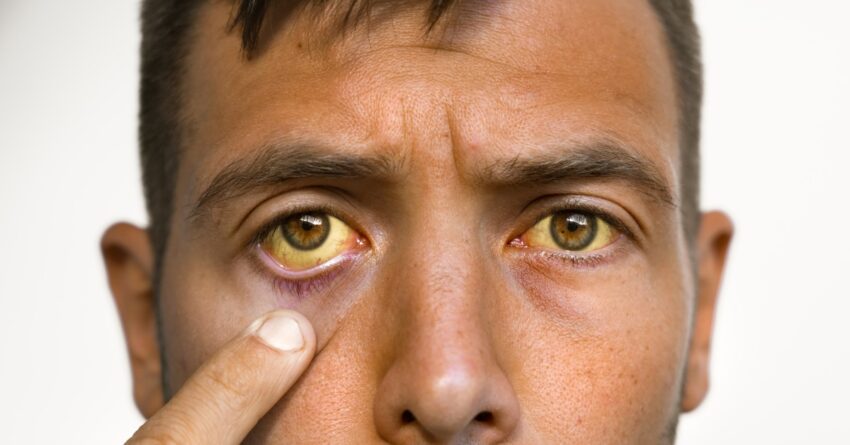A large amount of bilirubin, a yellow-orange pigment found in bile, is responsible for the yellow hue. The liver produces a fluid called biberal secretion. Breaking down red blood cells causes the production of the waste product bilirubin.
The skin, eyes, and mucous membranes of a person with moderate bilirubin levels can turn yellow. The colour might also shift from yellow to green as time goes on. Biliverdin, a green pigment found in bile, is responsible for the hue.
Usually, jaundice is caused by a medical condition and affects people of all ages. The most vulnerable people to jaundice are newborns and the elderly.
How is jaundice caused in the human body?
Blood bilirubin levels rise as red blood cells break down, which is a natural process. Usually, the liver filters this waste out of the bloodstream and converts it to conjugated bilirubin, a new type of bilirubin. After that, the new form exits the body through a person’s stool.
If the liver is unable to process enough bilirubin, it can build up in the body. The yellowing of the skin and eyes is caused by hyperbilirubinemia. Hyperbilirubinemia treatment is recommended depending on the symptoms and severity of the condition.
A condition that causes excess bilirubin production or prevents its elimination usually causes jaundice.
The following are some of the possible underlying conditions and causes of jaundice:
- Certain drugs’ adverse effects
- Gallstone disease as a result of high alcohol consumption
- Infections of the liver, such as hepatitis cirrhosis, a disease that causes the liver to become scarred, good tissue in the liver hepatitis or other liver illnesses
- Anaemia caused by hemolysis
What are the warning signs that jaundice may cause?
The following signs in patients with jaundice should be taken seriously:
- Tenderness and severe stomach pain
- Drowsiness, agitation, or confusion are examples of changes in mental function.
- Blood in the faeces or a tarry black faeces
- Vomit with blood
- Fever
A proclivity for bruising or bleeding easily, which might manifest as a reddish-purple rash of tiny spots or bigger splotches (which indicate bleeding in the skin)
A serum bilirubin level of more than 2.5 to 3 mg per dL (42.8 to 51.3 per L) in combination with a clinical appearance of yellow skin and sclera is the conventional diagnosis of jaundice. Pre hepatic, intrahepatic, and posthepatic metabolism are the three stages of bilirubin metabolism. Jaundice can occur if any of these steps are disrupted. To get immediate treatment for jaundice, reach out to a jaundice specialist in Coimbatore for necessary procedures.
Types of jaundice:
Pre-hepatic jaundice:
Pre-hepatic jaundice is caused by circumstances that increase the rate of hemolysis in your blood. Red blood cells are broken down in this process, releasing haemoglobin and turning it into bilirubin.
Bilirubin overflows into bodily tissues because the liver can only digest so much at once.
This type of infection is mostly caused by:
- Malaria is a parasitic blood infection, and sickle cell anaemia is a hereditary disorder in which red blood cells become crescent-shaped instead of disc-shaped.
- Thalassemia, a genetic condition that causes your body to manufacture an abnormal kind of haemoglobin, limiting the quantity of healthy red blood cells in your bloodstream spherocytosis, a genetic condition that causes the red blood cell membrane to be sphere-shaped rather than disc-shaped
Hepatic jaundice:
Hepatic jaundice occurs when your liver is scarred, damaged, or dysfunctional. As a result, it is less effective at removing bilirubin from your blood.
Bilirubin accumulates in the blood because it cannot be cleared out by the digestive system.
Included in this list of common causes are:
- Long-term exposure to infections or toxic substances, such as excessive amounts of alcohol, causes liver cirrhosis. Viral hepatitis is an inflammation of the liver caused by one of several viruses that can enter your body by infected food, water, blood, stool, or sexual contact.
- Primary biliary cirrhosis occurs when the bile ducts are damaged and unable to process bile, leading it to build up in the liver and cause damage. Reach out to the Coimbatore Best Hospital to undergo jaundice treatment.
- Alcoholic hepatitis is a condition in which your liver tissues are scarred as a result of heavy, long-term alcohol consumption.
- Leptospirosis is a bacterial infection carried by infected animals or contaminated animal urine or faeces, which can cause liver cancer in humans.
Post-hepatic jaundice:
Post-hepatic or obstructive jaundice develops when bilirubin cannot be effectively discharged into the bile ducts or digestive tract due to a blockage.
Jaundice following hepatic disease can be caused by any of the following:
- Gallstones are hard calcium deposits in the gallbladder that can cause bile duct blockage.
- The formation and spread of cancer cells in the pancreas, an organ that aids in the production of digesting chemicals, is known as pancreatic cancer.
- The growth and spread of cancer cells in your bile ducts are referred to as bile duct cancer.
- Pancreatitis is an inflammation or infection of the pancreas, while biliary atresia is a blockage of the bile duct.
- A genetic disorder in which your bile ducts are narrowed or absent.
How is the treatment for jaundice performed?
The underlying illness, as well as any complications it may create, treatment of liver jaundice is recommended as needed. If the jaundice is caused by acute viral hepatitis, it may go away on its own when the liver’s condition improves. Even if the jaundice goes away, hepatitis can become chronic. Unlike neonates (see hyperbilirubinemia), adults do not require therapy for jaundice.
Itching usually goes away when the health of the liver improves. If itching is a problem, cholestyramine taken orally may assist. When a bile duct is entirely clogged, however, cholestyramine is ineffective.
A technique to open the bile duct may be performed if the cause is a clogged bile duct. Using devices inserted via the endoscope, this operation is frequently performed during ERCP.
Is jaundice considered severe?
Yes, if left untreated for a long time, jaundice can be fatal. Jaundice can also progress to a life-threatening illness in some situations. It’s critical to seek medical attention as soon as you see the first signs of jaundice. Immediately reach out to the best hospital for jaundice in Coimbatore to prevent the condition from advancing.
When severe jaundice is not addressed, it can lead to a condition known as kernicterus. When a baby’s blood contains too much bilirubin, it can result in a condition known as kernicterus, a kind of brain injury. Hearing loss and athetoid cerebral palsy are two possible outcomes.
If you detect yellowing of your skin or the whites of your eyes, see your jaundice specialist doctor very once. Some causes can be cured by making dietary or lifestyle changes, while others may require immediate surgery or long-term treatment.

